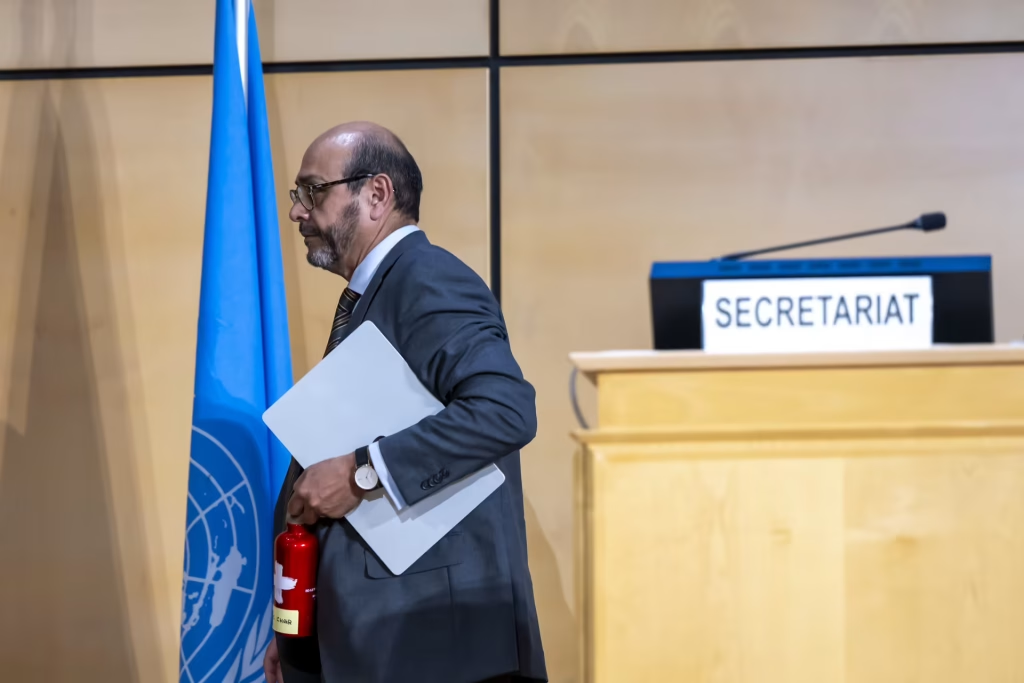The Foil of Ambition: How Consensus-Based Decision-Making is Sabotaging a Global Plastic Treaty
“Consensus is worth seeking if it moves us forward, not if it stalls the process”
Senimili Nakora, Fiji Delegate at The UN Plastic Treaty Talks in Geneva
At 7am on 15 August 2025, the chair of the UN Intergovernmental Negotiating Committee (INC) on plastic pollution formally closed what was meant to be the final negotiation round without agreement on a treaty text after marathon sessions, including a final overtime negotiation session that lasted over 24 hours, ended in deadlock with no consensus on a legally binding instrument.
The outcome was stark: no agreement, no legally binding instrument, no confirmed date or venue for the next round and no mandate for intersessional work. This collapse underscored both the urgency of the plastic crisis and the fragility of multilateralism, especially with negotiations defaulting to consensus-based approaches.
The INC, created in 2022 at the UN Environmental Assembly in Nairobi, after 175 countries signed a resolution initiating negotiations for a legally binding instrument to end plastic pollution across its full lifecycle, convened for its fifth session (INC-5.2) in Geneva for ten days of talks. The meeting drew more than 2,7000 participants, including 1,400 delegates from 183 countries.
Many observers mentioned that the ten days of negotiations felt like “Groundhog Day”. Small Island Developing States (SIDS), some of the most vulnerable and directly impacted persons attending the talks, were also some of the most vocal critics of the outcome. The delegate of Tuvalu, speaking on behalf of the 14 Pacific Island states, warned that without global cooperation, “millions of tonnes of plastic waste will continue to be dumped in our oceans, affecting our ecosystem, food security, livelihood and culture”. Guatemala’s Chief Negotiator said, “We have not come up with a treaty that the planet so urgently needs”.
The Stakes: Why a Treaty Matters

Scientific evidence continues to mount that plastic pollution poses grave risks to human health and the environment. The reality is that plastics never truly disappear; they break down into smaller and smaller plastics–what we call microplastics–infiltrating ecosystems and human body systems. Already 460 million tonnes of plastic are produced annually, of which only 9% is recycled. The rest is either incinerated, landfilled or leaked into the environment. As David Attenboroguh has highlighted in his documentaries, the devastating impact of plastic waste on marine and terrestrial life is now impossible to ignore. A striking example is one of this this year’s award-winning Wildlife Photographers of the Year (WPY) winner Lakshitha Karunarathna whose photo captured ‘Toxic Tip’ of an elephant meandering through a field littered with plastic in Sri Lanka, with elephants increasingly forced to forage in waste dumps due to habitat loss–a haunting reminder that even the most majestic creatures cannot escape humanity’s waste. Plastics have now been found everywhere, from trapped in Arctic sea ice to human bloodstreams, inlcuding placentas and breast milk.
The OECD projects that without action, plastic production will rise by 70% between 2020 and 2040, and by 2070, plastic waste could triple. For small island states like Tuvalu and Fiji, where oceans, food security and culture are directly threatened by plastic pollution, the stakes are seen as existential. As a negotiator from Madagascar articulately put it, “we cannot ignore the gravity of the situation. Every day, our oceans and ecosystems and communities are suffering from the consequences of our inability to make decisive and unified actions”.
The Montreal Protocol, adopted in 1987 to phase out ozone-depleting aerosols, is a great example of what a multilateral treaty can achieve and why a global plastic treaty could have a significant impact.
Core Divide: Production at Source vs Waste Management
The Geneva session exposed irreconcilable differences over the scope of the treaty, with fault lines forming between a majority of countries and a minority of oil-producing states. The High Ambition Coalition (HAC)–including the EU, Pacific Island states, and many African and Latin American countries–pushed for binding commitments to reduce production, phase out harmful chemicals, reduce the amount of plastic entering aquatic ecosystems, implementing cleanup programs for plastics aleady in the environmental; essentially, tackling plastic at every stage of its lifecycle, turning the tap off right at its source and all throught the supply chain. The OECD states that plastic production and disposal account for roughly 3.5% of global greenhouse gas emissions, with 90% of these emissions coming from the production stage, primarily the extraction and refining of fossil fuels into plastic.
In contrast, the Like-Minded States, a bloc composed primarily of petrochemical and oil-producing states led by Saudi Arabia and flanked by states including the Russia, Iran, Iraq, Kurwait, India and Malaysia, argued the treaty should focus only on managing the pollution that comes after plastic production; in other words, this bloc wanted the treaty to focus only on recycling, reuse and waste management. They opposed measures to limit production, seeing plastics as critical to their economic futures. For fossil-fuel producing states, plastics are considered a vital part of a post-oil economy as demand for petrol and diesel falls with the rise of electric vehicles (EVs) and the general push towards the clean energy transition. In the eyes of the French Environment Minister, Agnès Pannier-Runacher, rather than the health of their populations and the planet, this small group of countries was guided by short-term financial interests, leading them to block the adoption of an ambitious treaty.

The U.S. delegation, too, sought to remove all references to the “full life cycle of plastics” from the text and resisted calls for any binding treaty provisions and global measures, preferring a nationally determined approach (similar to how the Paris Accord is grounded in voluntary, self-determined commitments) as a way to bypass accountability. A secondary / domino risk associated with the U.S. position, especially under the Trump Administration, is that many states fear pressure that the U.S. will impose sanctions on states that support binding measures. Interestingly, while under the new Trump administration, the U.S. shifted its position and started to visibly align with the Like-Minded Bloc–an alarming move for the rest of the delegations since the U.S. is the second largest plastics producer in the world–China appeared to start siding with the more ambitious countries.
During INC-5.1 last year in Busan, South Korea, over 100 countries backed ambitious provisions. However, the draft remained riddled with brackets (gaps that still had to be agreed on), signalling disagreement mainly with this minority group with no time left to resolve it.
This year, Chair Luis Vayan Valdivieso attempted to break the impasse by producing two draft treaty texts. The first omitted key provisions, including any mention to limits on production, controls on harmful chemicals, global rules on products and financing arrangements. Commitments were essentially watered down to largely voluntary national measures–nothing was legally binding. HAC states rejected it outright as unfit for discussion. It was seen as so objectionable that countries said it was “repulsive” and “unacceptable”; Panama even added, “This is not ambition, this is surrender”. The failure of the first proposed draft forced negotiators back into meetings, pushing the talks over the 14th August Deadline and when a second draft circulated at 1am on the final night, it included some improvements but still left out core elements and the language was still largely voluntary. For many, it remained tilted towards the demands and interests of petrochemical producers and low-ambition states.
In the Geneva talks, the negotiating process itself became a major obstacle. Following the general procedural guide of multilateral environmental negotiations (MEAs), the INC defaulted to consensus decision-making, meaning every country had to agree to any proposal in the treaty before progress could be made. The failed talks highlighted the growing challenge of trying to reach a consensus. At Geneva, consensus ended in deadlock on key issues, such as whether the treaty should impose caps on new plastic production or simply focus on waste management and reuse. While the provisions rules state decisions should be made by a two-thirds majority vote if consensus fails, that provision was never formally adopted during the five rounds of INC negotiations. This is because during INC-2 in Paris, a minority of oil-producing countries rejected these rules. Important to note is that this dynamic is not new in MEAs. In the 1990s, petrostates used the same tactic to block the adoption of voting norms before COP1.

As a result, advocating for majority voting has become a political minefield and consensus voting became the only option to secure a treaty during INC-5.2 which in practice meant that it empowered a small number of countries with vested interests in fossil fuel and plastic industries–obstructionist states from the like-minded bloc–to act as a veto power. The like-minded states leaned heavily on consensus as a deliberate delay tactic to stall progress. Driven by their vested interests, they hijacked the negotiations. The delegation of Kuwait argued, “any attempt to move forward without consensus risks producing an instrument that is neither legitimate nor implementable”. However, as David Azoulay, a senior attorney at the Center for International Environmental Law, said, fossil-fuel producing countries had “laid a number of procedural traps to make it [voting] potentially politically costly and complicated”. Moreover, he rightly pointed out that associating multilateralism exclusively with consensus decision-making is incorrect (or in his words “complete and utter nonsense”), pointing to the UN General Assembly, where the majority voting tool is “not weakening multilateralism, it is saving it”. Azoulay has been a leading voice on the risks of consensus being used as the default in MEAS, highlighting the “tyranny of consensus” that was witnessed at INC-5.2.
“This meeting has proved consensus is dead. There’s no way we can proceed with consensus… the result was the chaos you saw”
Bjorn beeler, executive director and international coordination at the international pollution elimination network
Several nonprofits and advocacy groups staged several silent protests during the Geneva talks, displaying signs reading, “consensus kills ambition”. One of the risks posed by consensus-based decision-making becoming the norm in MEAS is that the threat of a vote can’t be used to nudge obstinate countries away from their red lines. While many countries in the ambitious camp said they repeatedly compromised and crossed their red lines, this was not reciprocated by the petrostates who hardly budged. Another risk with the consensus approach that has been pointed out is that it favours a treaty much closer to the like-minded than the high-ambition position–the least-common-denominator outcome (essentially a watered-down agreement).In fact, some blame the lack fo voting for dragging down ambitions throughout the UN climate negotiation process, and worry the plastic treaty process faces the same threat. This is why observers have called for a different model of negotiations to be adopted moving forward, stating that unless decision-making by a majority vote is introduced, this stalemate dynamic is unlikely to change.
Better No Treaty Than A Toothless Treaty?
For many high-ambition countries and civil society observers, the failure in Geneva, while deeply frustrating, was also preferable to locking in a weak agreement. In fact, rallies were held throughout the ten days against compromising a watered-down agreement that did not address production at source, displaying signs reading, “weak UN treaty fails the world”. Accepting a least-common-denominator treaty was seen as risking enshrining the interests of petrochemical producers in international law and making future ambition to properly tackle plastic pollution harder to achieve. Several negotiators stressed that it was better to walk away with no treaty than to codify a hollow instrument that may have looked decisive on paper but done little in practice. In other words, many saw a weak treaty as worse than a delayed treaty. Jessika Roswall, the EU Commissioner for Environment, Water Resilience and a Competitive Circular Economy, expressed that the EU would not accept a “stillborn treaty”. Christina Dixon said, “It’s better we take the time to get something good, and it’s good that countries hed that line in the face of pressure to get a deal”, after 100 countries refused to accept the two drafts proposed. In that sense, it could be argued that collapse also showed resilience and reassurance that the international community did not settle for a weak, watered-down treaty.

Some optimism was felt in the fact that the meeting ended with a clearly expressed desire by Member States to continue the process, with many insisting that this was not the end. As Alexandra Harrington wrote in her LinkedIn post, “there is momentum” and “every session brings together more voices”. Others consider it a wake-up call. Delegates from China even mentioned that the setback could represent a new starting point to forge consensus. It will likely not be until next year until we find out when the next round of negotiations will be. What happens between now and the next session is important; it could be a time to work on bridging political divides and building broader alliances that coordinate more closely. Additionally, only with time will we find out if states will be bold enough to advocate the use of procedural tools such as voting that are in place if consensus fails.
The Option to Sign a Treaty outside the UN Track
Another option is that the ambitious countries break free from blockers and forge a treaty outside the UN system. An example of successful multilateralism that occurred outside the UN framework was the Anti-Personnel Mine Ban Convention, more commonly known as the Mine Ban Treaty. Key countries, including Canada and Austria, formed a “core group” that bypassed traditional UN-led disarmament forums, which they perceived as being too slow or resistant to an outright ban. The UN track failed mainly due to the requirement for consensus, which led to lengthy deadlock and watered-down proposals because a few major powers, who relied on landmines for security, deliberately used the consensus requirement as a stalling tactic. To avoid deadlock, at Ottawa, the process adopted a two-thirds vote rule if consensus couldn’t be achieved, enabling decisive action and strong treaty language. A binding treaty was reached that avoided the lowest common denominator outcomes and came into force in 1998; it is widely considered a strong global norm against anti-personnel mines and the Ottawa process is seen as a template for mobilising global coalitions separate from UN frameworks.
“When you take the climate emergency and you take the emerging health crisis, I think we have two very strong impetuses to act there. I think, failure to act is potentially catastrophic for society and human health in the future”
Christina Dixon on the International risk Podcast
That being said, while the Treaty has led to a dramatic reduction in mine use and casualties, recognised as saving thousands of lives and stigmatising the weapon, many key military powers, including the U.S., Russia, China and India are still non-signatories. In recent conflicts in Ukraine and Myanmar, the use of landmines has continued or increased, with some states considering withdrawal due to security concerns. Alexandra Harrington writes, “I do think if we continue to see this type of deadlock, and such an inability to move forward in the negotiations, there could indeed be much more interest in going outside.” Some states could move ahead with their own agreement and others could join later, respecting that not all countries can engage in such a treaty at this stage. It raises questions about how legitimate and impactful it would be for the ambitious countries to break away from the UN track.
Overall, the Geneva collapse highlights the fragility of consensus-based multilateralism, especially in an age of increasing polarised interests and views over major global security issues. Moreover. The paralysis in Geneva has conveyed that tackling plastic pollution requires a head-on approach, not hiding behind consensus.


